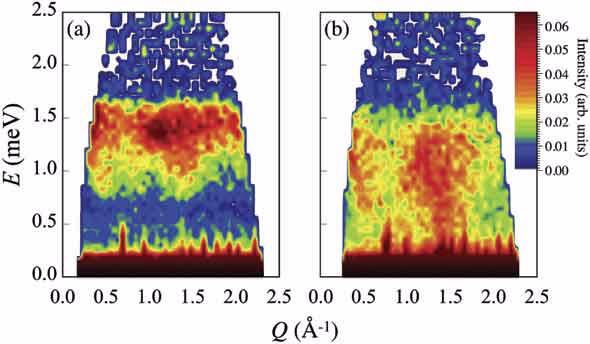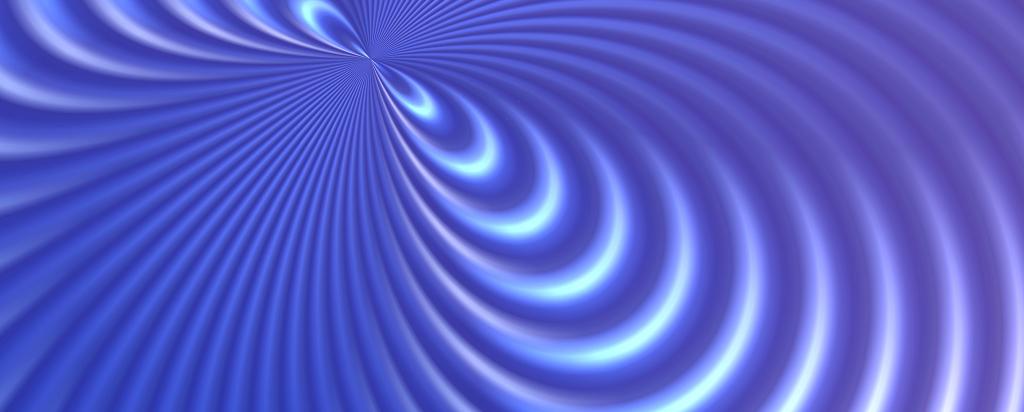

Published on the 27th February 2018 by ANSTO Staff
Inelastic neutron scattering data from Pelican instrument at 1.5 K (a) and 4.0 K (b). Spin gap is evident (lower blue band ) at 1.5 K (a)

Nuclear techniques at ANSTO have helped to confirm a quantum spin phenomena, a Haldane phase, in a magnetic material, that has potential to be used as a measurement model for quantum computation.
Although there has been experimental evidence of the Haldane phase in other types of one dimensional antiferromagnetic materials, it is believed to be the first evidence in a cluster-based material.
“The neutron spectrum from Pelican provided the very data that confirmed Haldane state exists in fedotovite as proposed by our other measurements and theoretical studies. The neutron data showed both spin gap and dispersion, that are characteristics of the Haldane state,” said lead author A/Prof Masayoshi Fujihara of the Tokyo University of Science.
In an article published in Physical Review Letters as an 'Editors’ Suggestion' , a large collaboration of researchers, led by physicists from Japan, ANSTO instrument scientists Drs Richard Mole, Dehong Yu and Shinichiro Yano of the National Synchrotron Radiation Research Centre in Taiwan (who operates the Taiwanese instrument Sika at ANSTO), shared experimental evidence of the Haldane phase in fedotovite.
The framework for this unusual state of matter was predicted by Prof Duncan Haldane, who shared the Nobel Prize in Physics for the development of the ‘topological phases of matter theory’ with David Thouless and Michael Kosterlitz in 2016.
Quasi one dimensional spin systems, such as fedotovite K2Cu3O (SO4)3, have an unusual magnetic behaviour at very low temperature, in which the ground state is a one-dimensional chain in a triplet configuration with S=1 spin.
The S=1 occurs because there are an even number of S=1/2 on the magnetic Cu2+ ions at the ends of spin chain, as predicted by Haldane.
“Quasi-one dimensional chains such as fedotovite do not have a single spin but a group of spins forming a cluster. One cluster of atoms then weakly interacts with the neighbouring cluster of atoms,” said Mole.
Magnetic coupling occurs because of super exchange interactions between the spin clusters and small antiferromagnetic coupling within the cluster.
“That gapped behaviour is observable in the Pelican spectrum, which is highly sensitive to weak magnetic interactions,” said Mole.
The fedotovite has a unique arrangement of magnetic ions and two-stage magnetic behaviour.
Inelastic neutron scattering on the Pelican time-of-flight spectrometer captured the spin gap at 1.5 K with a magnitude of 0.6. meV which closes at 4.0 K. The measurements were in agreement with theoretical predictions.
“We are talking about very small amounts of energy but the gap is real,” said Yu.
“The Haldane state will emerge whenever the number of tetrahedral in the spin cluster chain is even but not odd as predicted by our theoretical calculations in this paper,” said Yano.
The crystal structure of the mineral fedotovite was originally determined by Russian scientists in the 1990’s, however the current work utilised a newly developed synthetic method in the Fujiahala lab at Tokyo University of Science.
It allowed for large quantities of high purity sample to be made which was essential for the neutron scattering experiments.
The crystal structure was determined by X-ray diffraction at the Photon Factory, High Energy Accelerator Research Organization (KEK) in Japan.
Other experimental methods in addition to inelastic neutron scattering were used in the research included magnetic susceptibility, magnetisation, heat capacity and theoretical modelling.
Collaborators included scientist from Tokyo University of Science, the High Energy Accelerator Research Organisation, Tohoku University in Japan, the National Synchrotron Radiation Research Center in Taiwan, and ANSTO.
https://doi.org/10.1103/PhysRevLett.120.077201